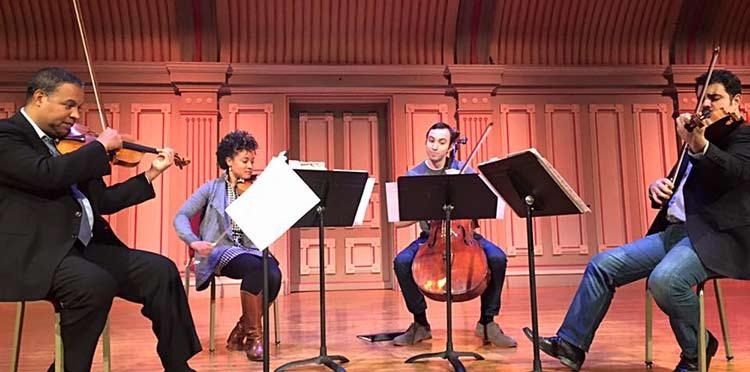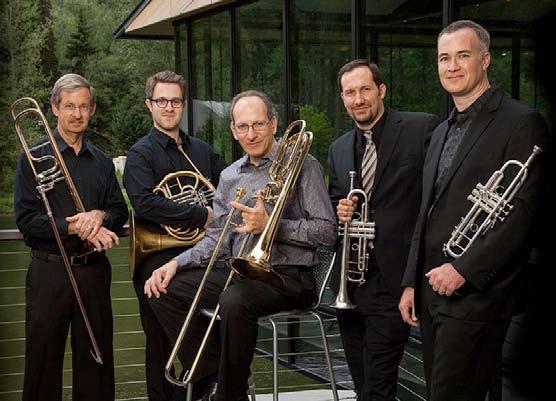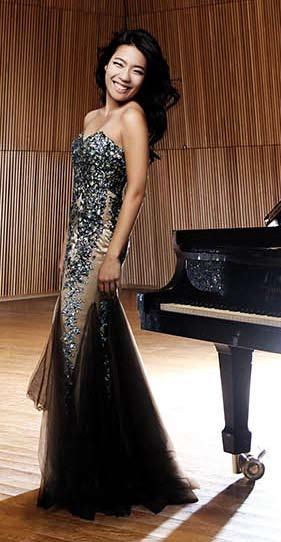
9 minute read
1. Harlem Quartet Sunday Oct. 4
Harlem Quartet
LudwigvanBeethoven(bornBonn,December16,1770;diedVienna,March26,1827) Quartet inFminor,op.95(“Serioso”)(composed1810)
Incidental music to Goethe’s “Egmont” occupied much of the early months of 1810 for Beethoven. The Hofburg Theatre never paid him for that score, even though they further imposed upon him to help prepare for the May 24th opening performance of the 1788 tragedy. Still, he remained in fairly good spirits. The reason? Probably his hopes of a possible marriage, thanks to the intercession of his friend Count Ignatz von Gleichenstein.
The Count, an official in the Viennese War Department, was enamored of Anna Malfatti, one of two sisters in an artistic family. Therese, the second sister, had been Beethoven’s piano student for some time, but in 1810, Therese was eighteen and Ludwig was in love. Gleichenstein, who would marry Anna in 1811, acted as a go-between in the futile wooing and eventually had to break the bad news to the stricken 39-year-old composer.
Beethoven survived the disappointment and even remained friends both with the Malfatti family and with Therese herself. She would marry a baron in 1817. A relative who knew her well would later say that she would always speak of Beethoven with reverence but “a certain reserve.” The tone of the “Quartet in F minor,” completed in October 1810, could be attributable to the composer’s frame of mind, although such one-dimensional correspondences oversimplify the process of composing and its relationship to living. Nonetheless, the autograph score is inscribed “Quartett Serioso” and stands as one of the few works whose nicknames sprang from Beethoven’s own pen.
Serious it is, at least for the first three movements. The impetuous unison opening fragments into four separate voices bouncing off each other; calm is restored with the second theme. Following a startling key change, the succinct development dwells exclusively on the first theme, as does the coda. As abruptly as it began, the movement ends, though quietly now and sounding oddly unfinished.
Alone, the cello introduces the “Allegretto ma non troppo,” then passes the lead on to the first violin, which weaves a long, increasingly chromatic tune. The viola instigates the fugal midsection. A return of the cello’s prelude signals the return of the first section, now an octave higher and beginning to meld with the viola theme.
After a mere pause, the “Allegro assai vivace ma serioso” springs to tense and turbulent life. The syncopations and silences of the opening bars pervade the scherzo, contrasting sharply with the trio’s chorale-like melody in the three lower strings and odd first violin accompaniment. The scherzo sounds three times, alternating with the twice-heard trio. Each repeat is shorter than the one before.
The brief “Larghetto espressivo” gives way to the rondo-sonata “Allegretto agitato,” the violins trading honors until the brief development. The coda is announced by a change in meter and key as entirely new thematic material sweeps to the unison close.
Harlem Quartet
WilliamBolcom(bornSeattle,May26,1938) ThreeRags(composed1989) William Bolcom was eleven years old when he began to study composition with John Verrall at the University of Washington, from which he earned his BA in 1958. At Mills College beginning in 1958, he studied with Darius Milhaud, finishing his MA in 1961. Moving on to the Paris Conservatoire, he studied with both Milhaud and Olivier Messiaen. Bolcom was granted his DMA from Stanford in 1964 after further studies with Leland Smith.
Bolcom’s earliest compositions tended toward serialism, but while teaching at Queens College, City University of New York, 1966-1968, he discovered the music of Scott Joplin. As one of the leaders of the ragtime renaissance, Bolcom both performed works of Joplin, Eubie Blake, and others, and composed his own rags. In the process, he was instrumental in dismantling some of the walls separating academic and popular music. Because of Bolcom’s reversion from serialism back to the modern, “New Yorker” critic Alex Ross dubbed him “the boldest of neotonalists.” Even before Bolcom and mezzo-soprano Joan Morris married in 1975, the couple toured and recorded programs on the history of popular song in the United States. Bolcom’s “Twelve New Etudes” for piano won the Pulitzer Prize for music in 1988. In 1993, he was elected to the American Academy of Arts and Letters. The 2006 recording of Bolcom’s magnum opus, his settings of the 46 poems in William Blake’s “Songs of Innocence and of Experience,” received four Grammy Awards, including for Best Classical Contemporary Composition. “Musical America” named Bolcom Composer of the Year for 2007.
In “Three Rags,” Bolcom took three of his existing piano rags, adapting and arranging them for string quartet in 1989. Dedicated to Emanuel Borok, concertmaster of the Dallas Symphony Orchestra, “Three Rags” received its premiere performance in 1994 by the Lark Quartet. “Poltergeist,” originally composed in 1970 as one of the “Three Ghost Rags”, explores nearly every ‘frozen’ appoggiatura and substitution in the harmonic book, in Bolcom’s account. “Graceful Ghost,” also originally from the 1970 set of “Three Ghost Rags,” is probably Bolcom’s most familiar piece, written in memory of his father. “Incineratorag,” dating from Bolcom’s 1967 set of “Three Classic Rags” is indeed in the three-part form of the classic rag, lively on both ends and more subdued in the middle.
Harlem Quartet
Dizzy Gillespie (born Cheraw,South Carolina,October 21,1917;died Englewood,New Jersey,January 6,1993) A Night in Tunisia (composed around 1941-1942;arranged by Dave Glenn) “We had some fundamental background training in European harmony and music theory superimposed on our own knowledge from Afro-American musical tradition,” wrote Dizzy Gillespie in “To Be, or Not … to Bop” in 1985. “We invented our own way of getting from one place to the next.” That mode of transport, developed in jam sessions that included such fellow pioneers as saxophonist Charlie Parker, pianist Thelonious Monk, and drummer Kenny Clarke, came to be known as bop.
John Birks Gillespie lost his father, an occasional bandleader, when he was ten, but not before father had passed enough basic musical knowledge and skills onto son. Gillespie taught himself trumpet, which got him into the Laurinburg Institute in North Carolina in 1933, where he studied theory and harmony. By 1935, he was making the rounds of the era’s jazz bands, earning the nickname “Dizzy” for his sense of humor.
Accounts differ about whether Gillespie was in the band of saxophonist Benny Carter or that of pianist Earl Hines, around 1941-1942, when he noticed that a chord progression he was playing around with on the piano had an especially unusual Latin flavor. Superimposing a bebop rhythm onto the chord progression, Gillespie “introduced a special kind of syncopation in the bass line,” as he would later explain. This innovative detour from what was then the common “walking bass” of simple quarter notes marked a turning point in the history of jazz.
The composition was originally entitled “Interlude,” with words by the vocalist Sarah Vaughan. At some unknown point, the title became “A Night in Tunisia” and vocalist Jon Hendricks wrote a fresh set of lyrics more appropriate to its new title. Roughly four decades later, Hendricks returned to the work in one of his trademark blends of words and vocalese, called it “Another Night in Tunisia, and won a Grammy. This string quartet arrangement of “Night in Tunisia” is by trombonist Dave Glenn (born August 10, 1951), director of jazz studies at Washington’s Whitman College.
GuidoLópez-Gavilán(bornMatanzas,Cuba,January3,1944) CuartetoenGuaguancó(composed2005,arranged2016) Born in 1944 in the northern coastal city of Matanzas, Cuba, Guido López-Gavilán graduated in 1966 from Havana’s Conservatorio Amadeo Roldán with a degree in choral conducting and in 1973 from Moscow’s Tchaikovsky Conservatory with a degree in orchestral conducting. López-Gavilán received the 2005 UNESCO Medal in Chile. He has trained several generations of Cuban conductors, conducted around the world, and in 2012 led the National Symphony Orchestra of Cuba on a United States tour. Cuba’s Ministry of Culture awarded him its highest honor, the National Prize of Music in 2015. In 2016, his recording “Caribe Nostrum” was given the Gran Premio Cubadisco.
Ilmar Gavilán, Harlem Quartet violinist and son of the composer, has written the following about his father’s Cuarteto en Guaguancó:
Harlem Quartet
Guaguancó is both a dance and a distinctive rhythmic pattern. Like most Cuban music, the rhythmic foundation for Guaguancó is based on the clave – a rhythmic ostinato that can be arranged in several ways. Guagancó is known for its characteristic delay on the third clave accent. This delay creates what is known as a rumba clave pattern, the rhythmic underpinning for the Cuban rumba style. Cuarteto en Guaguancó is unique among string quartet repertoire not only for these Cuban rhythmic elements, but also for the way it traces its sonority back to melodic chanting of the West African Yoruba tradition.
Cuarteto en Guaguancó was originally composed for chamber orchestra in 2005 and arranged for the Harlem Quartet in 2016. “My father was not nice to us,” Ilmar Gavilán joked in a 2017 New Orleans Advocate interview. “He wrote a hard piece for us to perform. When you boil down something written for an orchestra to just four people, it becomes even more intricate.”
Claude Debussy (born St.Germain-en-Laye,August 22,1862;died Paris,March 25,1918) Quartet in G minor,op.10 (composed 1893) The fact that Claude Debussy published his only string quartet under the title “Premier Quatuor” suggests that he intended to venture at least once more into that genre at some point in his career. When fellow composer Ernest Chausson (1855-1899) expressed dismay at the Quartet in G minor, Debussy wrote that his next such work would prove more worthy of his friend’s respect. When the two had a falling out, however, Debussy apparently abandoned plans for a second quartet. The one that does exist has since become one of the most important and popular quartets in the repertoire.
In the opening moments of the first movement of the quartet (Animé et très décidé -- animated and very determined) can be found the seeds for virtually the entire work. A fluid melody is passed from violin to cello. The second subject is restated in the development, neglected in the recap, and finally returns in the coda. The rhythmically fascinating scherzo (Assez vif et bien rytmé -- rather lively and rhythmic) opens with the bowed viola over pizzicato accompaniment. The viola theme, derived from the opening movement’s germ motif, later evolves into an augmented version in the first violin.
The Andantino, doucement expressif (gently expressive), which opens and closes with muted strings, seems furthest away from the initial seed measures of the first movement, although some commentators have found a connection. The introduction to the finale (Très modére -- very moderate) reverts to the overt use of the seed passage, then moves to a fugato setting in the cello. The second subject again treats the seed motif. It is Debussy’s employment of uncommon juxtapositions of common chords, his use of modal flavors, and the influences ranging from Wagner’s cyclic forms to the textures of the Javanese gamelan that have help establish his lone quartet as one of the cornerstones of the literature.
-- Program notes by Jay Weitz, Senior Consulting Database Specialist for music, OCLC Online Computer Library Center, Dublin, Ohio. For over three decades, he wrote about the arts in Central Ohio for the daily papers “Columbus CitizenJournal” and “Columbus Dispatch,” the alternative weekly papers “Columbus Guardian” and “Columbus Alive,” and Columbus public radio station WCBE-FM.







